Severin Roesen (1815-1872)
Get a Roesen Certificate of Authenticity for your painting (COA) for your Roesen drawing.
For all your Roesen artworks you need a Certificate of Authenticity (COA) in order to sell, to insure or to donate for a tax deduction.
Getting a Roesen Certificate of Authenticity (COA) is easy. Just send us photos and dimensions and tell us what you know about the origin or history of your Roesen painting or drawing.
If you want to sell your Roesen painting or drawing use our selling services. We offer Roesen selling help, selling advice, private treaty sales and full brokerage.
We have been authenticating Roesen and issuing certificates of authenticity since 2002. We are recognized Roesen experts and Roesen certified appraisers. We issue COAs and appraisals for all Roesen artworks.
Our Roesen paintings and drawings authentications are accepted and respected worldwide.
Each COA is backed by in-depth research and analysis authentication reports.
The Roesen certificates of authenticity we issue are based on solid, reliable and fully referenced art investigations, authentication research, analytical work and forensic studies.
We are available to examine your Roesen painting or drawing anywhere in the world.
You will generally receive your certificates of authenticity and authentication report within two weeks. Some complicated cases with difficult to research Roesen paintings or drawings take longer.
Our clients include Roesen collectors, investors, tax authorities, insurance adjusters, appraisers, valuers, auctioneers, Federal agencies and many law firms.
We perform Severin Roesen art authentication, appraisal, certificates of authenticity (COA), analysis, research, scientific tests, full art authentications. We will help you sell your Severin Roesen or we will sell it for you.

Severin Roesen was a painter known for his still lifes of flowers and fruit. Born in Cologne, in Germany, he immigrated to the United States in 1848.
His studio was much frequented by his friends, who would sit all day with this genial, well read and generous companion, smoking his pipes and drinking his beer, and he was seldom without this beverage. . . . In one corner of the finished painting would always appear the faint outline of a beer glass, and when a customer objected to its presence, he would say, ‘Why, do you not like beer?’ and then take it out.—”August Roesen [sic], Artist: An Interesting Williamsport Genius Recalled by His Works,” (Williamsport Sun and Banner, June 27, 1895)
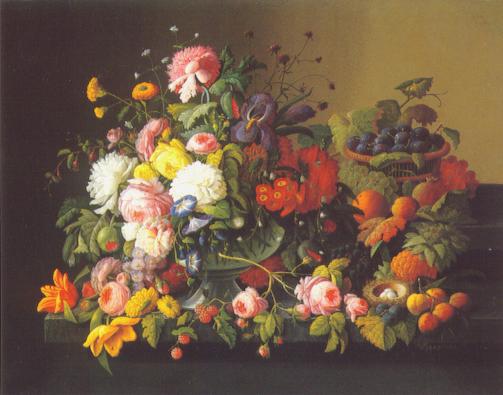
German native Severin Roesen is most famous for his abundant fruit and flower still lifes and is today recognized as one of the major American still-life painters of the mid-nineteenth century.
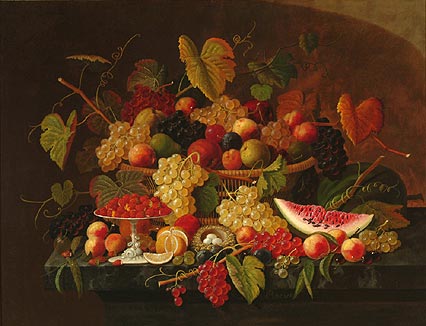
A large number of Roesens paintings were discovered in Williamsport, Pennsylvania, the booming lumber town where the artist lived from about 1860 to 1872. Roesen’s pictures of nature’s abundance found a ready market in the town’s growing population (many of German descent) of prosperous merchants and lumbermen, who purchased them to adorn their newly built homes as well as taverns, restaurants, and hotels. One hotelier and brewer, Jacob Flock, owned more than fifty paintings by Roesen, which were presumably traded for lodging and for beer, the artist’s favorite beverage.
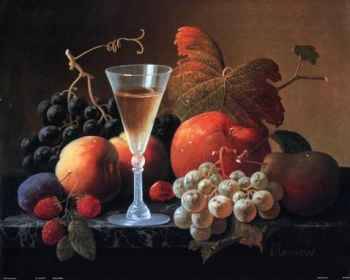
While Roesen’s paintings reveal a meticulous attention to detail in their precise arrangements and close brushwork, his subject matter, even down to specific motifs, did not change throughout his career. Sometimes he made near copies of paintings, but usually he merely rearranged and reassembled stock elements.
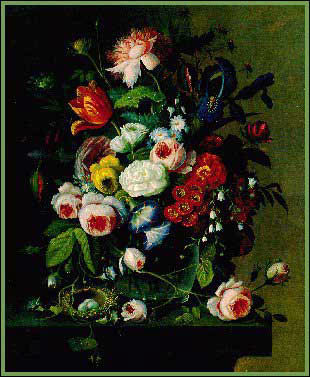
Numerous items in Fruit and Wine Glass, for example, also appear in other paintings. The footed desert plate full of strawberries is a common motif. The pilsner glass, sometimes accompanied by an open bottle of champagne, is interchangeable with a wine goblet filled with lemonade used elsewhere. The glass is nearly always placed at the lower left edge of the painting; a halved lemon often appears nearby. Branches full of grapes arranged from lower left to upper right provide the composition with a graceful S-curve and subtly lead the viewer’s eye over the entire display. Here the composition is balanced by light and dark grapes at either side and filled in by scattered raspberries, cherries, peaches, apples, pears, and apricots. Many of these compositional elements, if not the items depicted, were derived from seventeenth-century Dutch still life paintings by such artists as Jan van Huysem.
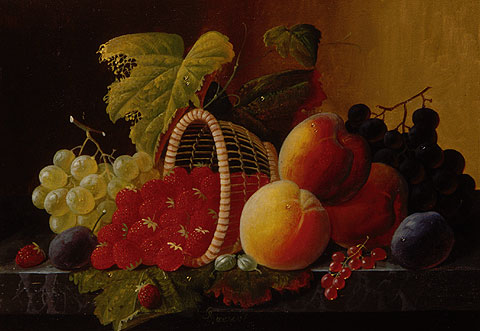
Little is known about Roesen. He came to New York around 1848 and exhibited for several years there at the American Art-Union. He probably left that city in the mid-1850s, and settled in Williamsport around 1860. His whereabouts after 1872 remain uncertain. Still wondering about a 19th century German still life painting in your family collection? Contact us…it could be by Severin Roesen.
